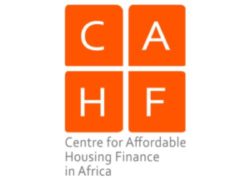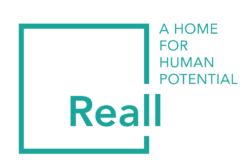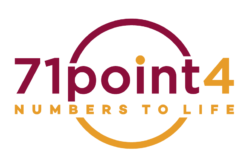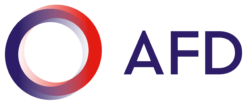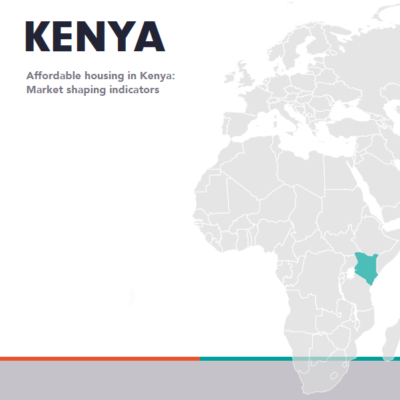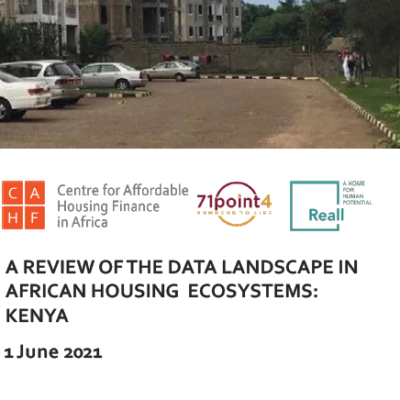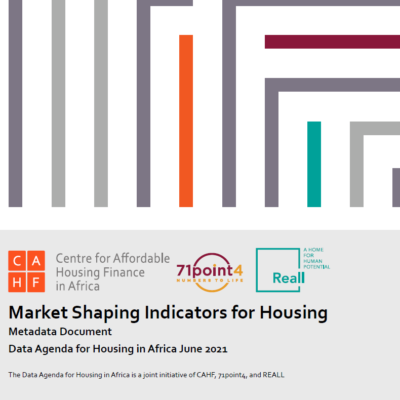Kenya - Market Shaping Indicators
View Reall projects in KenyaAs a priority country, in Kenya Reall is committed to expanding end-user housing finance solutions to 2.5 million previously excluded low-income and informally employed borrowers by 2025; addressing critical governance, policy, standards and regulatory barriers that impede the market; and resolving data voids and evidence gaps that have inhibited more effective solutions for affordable housing. CAHF has also been working in Kenya for some time, primarily through the publication of case studies that have explored the challenges and opportunities involved in delivering and financing affordable housing. Starting in 2021, CAHF is working with FSD Kenya, FSDAi and Reall in promoting an Affordable Housing Investment Alliance for Kenya, which will support market development through an Open Access Initiative.
Country Overview
Housing is a backbone of Kenya’s real estate sector, which contributed approximately 5.3 percent of gross domestic product (GDP) in the third quarter of 2020′. Championed by the government’s Big 4 Agenda, which established the Affordable Housing Programme (AHP), activities by both the private sector and government have increased to resolve the housing deficit that stands at two million and grows annually by approximately 200,000 housing units.
For the financial year 2020/21, the housing sector recorded a decline in budget allocation, attributed to constrained fiscal space as the government grapples with economic effects of COVID-19, which means reduced development of affordable housing. Financial access (formal and informal) is high in Kenya, having expanded to 89 percent in 2019 from 26.7 percent in 2006. However, mortgage uptake has remained relatively low with the number of mortgage accounts at 27,993 at the end of 2019, representing an increase of 1,806 accounts from December 2018.
State of Housing Data
The assessment of data availability and quality in Kenya’s housing sector has highlighted a number of gaps and limitations. Data gaps along various components of the housing value chain affect the ability to accurately measure investment in Kenya’s housing sector, contribution of housing to Kenya’s economy, and access to finance and affordability. The majority of the macroeconomic and financial data gaps can be closed through the disaggregation of existing data to allow for the analysis of the housing sector.
Kenya’s Central Bank is attentive to the need to collect and share housing finance data. The provision of disaggregated budget, government expenditure and high-level mortgage data would address the main data gaps. Private and public sector market players need to be leveraged to access and centralize data that would help improve segmenting the demand side and tracking housing supply. An important step is to develop an institutional data engagement approach to lobby and engage key market players on their important roles in collectively improving Kenya’s housing data landscape.
Text on this page is based on the MSI Kenya Country Profile’, drawn from Centre for Affordable Housing Finance (2020). Housing Finance in Africa Yearbook: 11th Edition 2020, with additional content from CAHF and Reall.
Key Indicators
1. Land & Infrastructure
% of urban bottom 40 households without access to basic sanitation services
| Country | Year | Data Source | Value |
|---|---|---|---|
| Cote d'Ivoire | 2012 | DHS | 96.5% |
| Ghana | 2014 | DHS | 93.15% |
| Kenya | 2014 | DHS | 88.25% |
| Morocco | 2004 | DHS | 52.05% |
| Mozambique | 2011 | DHS | 95.6% |
| Nigeria | 2018 | DHS | 83.1% |
| Tanzania | 2017 | DHS | 37% |
| Uganda | 2016 | DHS | 94.5% |
| Rwanda | 2016 | National Institute of Statistics Rwanda (NISR) | 13.13% |
| Pakistan | 2018 | The DHS Program | 2.75% |
| India | 2018 | NSSO 76th Round | 0.2% |
2. Construction & Investment
% of urban population living in slums, informal settlements, or inadequate dwellings
| Country | Year | Data Source | Value |
|---|---|---|---|
| Cote d'Ivoire | N/A | ||
| Ghana | N/A | ||
| Kenya | N/A | ||
| Morocco | N/A | ||
| Mozambique | N/A | ||
| Nigeria | N/A | ||
| Tanzania | N/A | ||
| Uganda | N/A | ||
| Rwanda | 2018 | World Bank | 42.1% |
| Pakistan | N/A | ||
| India | 2018 | NSSO 76th Round | 35% |
3. Sales & Rental
Number of residential mortgages outstanding
| Country | Year | Data Source | Value |
|---|---|---|---|
| Kenya | 2019 | Central Bank of Kenya | 27,993 |
| Nigeria | 2019 | NMRC | 32,260 |
| Tanzania | 2019 | Bank of Tanzania and Tanzania Mortgage Refinance Company Limited | 5,460 |
| Rwanda | 2020 | National Bank of Rwanda (NBR) | 44,177 |
| Pakistan | 2019 | State Bank of Pakistan - Housing Finance Data Review | 58,620 |
| India | 2020 | Reserve Bank of India | 9,817,180 |
3. Sales & Rental
Price of the cheapest, newly built dwelling by a formal developer or contractor
| Country | Year | Data Source | Value |
|---|---|---|---|
| Cote d'Ivoire | 2018 | Site d'annonce et promotion dans l'immobilier en Côte d'Ivoire | 15,500,000 CFA$27,087.48 |
| Ghana | 2019 | Damax Construction Co. Ltd | 108,704 GH₵$19,621.66 |
| Kenya | 2019 | Tsavo Real Estate | 4,000,000 Ksh$37,037.04 |
| Morocco | 2019 | Various real estate websites | 250,000 DH$27,027.03 |
| Mozambique | 2016 | Casa Minha | 3,418,491 MZ$48,147.76 |
| Nigeria | 2019 | Millard Fuller Foundation; Shelter Origins | 2,900,000 NGN$7,651.72 |
| Tanzania | 2018 | CAHF | 37,966,107 TZS$16,508.58 |
| Uganda | 2019 | Various property developers | 125,000,000 UGX$34,097.11 |
| Rwanda | 2020 | Marchal Real Estate Developers | 10,000,000 R₣$11,119.14 |
| Pakistan | 2021 | Partners | 2,500,000 PKR$14,305.33 |
| India | 2022 | Real estate websites and industry experts | 160,000 IN₹$2,176.87 |
3. Sales & Rental
% of national households that rent their dwelling
| Country | Year | Data Source | Value |
|---|---|---|---|
| Ghana | 2017 | Ghana Statistical Service | 28% |
| Kenya | 2019 | Central Bank of Kenya, Kenya National Bureau of Statistics, FSD Kenya | 35.01% |
| Morocco | 2014 | High Commission for Planning; World Bank | 18.5% |
| Nigeria | 2018 | World Bank; Nigeria National Bureau of Statistics | 21.8% |
| Tanzania | 2017 | National Bureau of Statistics | 80.56% |
| Uganda | 2016 | DHS | 53.45% |
| Rwanda | 2020 | Access to Finance Rwanda (AFR) and National Institute of Statistics Rwanda (NISR) | 8.94% |
| Pakistan | 2017 | Population and Housing Census | 11.53% |
| India | 2018 | NSSO 76th Round | 13% |
5. Enabling Environment
Ease of Doing Business Index Rank: Global
| Country | Year | Data Source | Value |
|---|---|---|---|
| Cote d'Ivoire | 2020 | World Bank | 110 |
| Ghana | 2020 | World Bank | 118 |
| Kenya | 2019 | World Bank Ease of Doing Business | 61 |
| Morocco | 2020 | World Bank | 53 |
| Mozambique | 2019 | World Bank | 74 |
| Nigeria | 2020 | World Bank | 131 |
| Tanzania | 2020 | World Bank | 141 |
| Uganda | 2020 | World Bank | 116 |
| Rwanda | 2020 | World Bank Ease of Doing Business Indicators | 38 out of 190 |
| Pakistan | 2020 | World Bank Doing Business Indicator | 108 out of 190 |
| India | 2020 | World Bank | 63 out of 190 |
6. Economic Environment
GDP Per Capita
| Country | Year | Data Source | Value |
|---|---|---|---|
| Cote d'Ivoire | 2018 | World Bank | 1,024,171 CFA$1,789.82 |
| Ghana | 2019 | World Bank | 11,489 GH₵$2,073.83 |
| Kenya | 2018 | World Bank | 173,272 Ksh$1,604.37 |
| Morocco | 2018 | World Bank | 30,725 DH$3,321.62 |
| Mozambique | 2018 | World Bank | 30,772 MZ$433.41 |
| Nigeria | 2018 | World Bank | 659,159 NGN$1,739.21 |
| Tanzania | 2018 | National Bureau of Statistics; World Bank | 2,297,020 TZS$998.80 |
| Uganda | 2018 | World Bank | 2,357,327 UGX$643.02 |
| Rwanda | 2019 | World Bank | 737,578.59 R₣$820.12 |
| Pakistan | 2020 | World Bank National Accounts Data | 188,900 PKR$1,080.91 |
| India | 2020 | Ministry of Statistics and Program Implementation | 151,760 IN₹$2,064.76 |
7. Demand
Population Size
| Country | Year | Data Source | Value |
|---|---|---|---|
| Cote d'Ivoire | 2017 | World Bank | 24,437,469 |
| Ghana | 2019 | World Bank | 30,417,856 |
| Kenya | 2017 | World Bank | 50,221,473 |
| Morocco | 2017 | World Bank | 36,471,769 |
| Mozambique | 2018 | World Bank | 29,495,962 |
| Nigeria | 2017 | World Bank | 190,873,311 |
| Tanzania | 2019 | World Bank | 58,005,463 |
| Uganda | 2017 | World Bank | 41,487,000 |
| Rwanda | 2019 | World Bank | 12,626,950 |
| Pakistan | 2020 | World Bank National Accounts Data | 220,892,331 |
| India | 2021 | Minsitry of Health and Family Welfare | 1,361,343,000 |
All Indicators
Please enter 3 or more characters to begin search.
You can then click on a result to be taken to the relevant tab.
The Market Shaping Indicators project is a work in progress. Significant gaps exist in data, which will be filled in future revisions. We would recommend checking back regularly for updates. We are keen to receive any feedback that you have on this Dashboard, which can be sent to [email protected].
Using the Dashboard
The indicators are split into 6 key areas, split into the Housing Value Chain: Land & Infrastructure, Construction & Investment, Sales & Rental, Maintenance & Management, Enabling Environment, Economic Environment and Demand, shown in the following tabs. Navigation can either be undertaken by using the tabs, or through the Search box immediately above. Above this, currency indicators can be toggled between USD and local currency.
Users are able to further interrogate each indicator each indicator through clicking on the arrows to the left of each indicator. This expanded section shows the data elements that are used to produce the overall indicator value, dates of data collection, source details, hyperlinks to the original data where possible, and a breakdown of data quality. The majority of indicators are quality assessed, based on the whether they are: Interpretable; Relevant; Sufficiently Accurate; Representative; Timely; and Accessible. Indicators are scored on each of these criteria using a 1-4 star system, detailed below:
☆ – poor
☆☆ – moderate
☆☆☆ – good
☆☆☆☆ – excellent
Finally, all data can be downloaded for further interrogation. By clicking on Switch to Data View at the top of the screen, users can filter data based on countries and columns, and download in a .csv or .xls file.
Bottom 40
Reall targets the Bottom 40% of the urban income pyramid, referred to as the ‘Bottom 40’ or ‘B40’. An objective of the MSI work was to better understand and demonstrate the market from the perspective of households in the Bottom 40, and as such data is aggregated for this group where possible. Data for this group can be particularly challenging to come across. In part, this is due to the difficulties in accurately defining this group using existing data sets. Additionally though, the informality of much of life for lower income groups severely limits data availability, particularly in terms of key data on jobs, housing and relationships with local government. This lack of data is a key blockage for further engagement at the lower end of the housing market, and resolving this is an objective of Reall’s and of the MSI work.
Aggregations
Data is shown at various different “aggregations”, which demonstrate the size and location of the population for which the data represents. This varies from national to city level in terms of population groupings. Additional aggregations exist for the Bottom 40, as detailed above, enabling a focused view on the lower end of the market.
For relevant data, Reall’s partners are also included as an aggregation. This is not meant to be representative of the entire market, but recognises that as practitioners and experts within the lower end of the housing market of each country, their experiences are a useful check on other data sets, and an indication of the value when other data is not available.
Terms of Use
Reall Ltd (“Reallâ€) endeavours to make its data as freely available as possible in order to demonstrate the successes of its model and encourage other actors into the affordable homes movement. Reall provides the user with access to these data free of charge subject to the terms of this agreement.
Users are encouraged to use the data to benefit themselves and others in creative ways.
Unless specifically labelled otherwise, you are free to copy, distribute, adapt, display or include the data in other products for commercial or non-commercial purposes for no cost under a Creative Commons Attribution 4.0 International License, with the additional terms below.  The basic terms may be accessed here. By using or downloading the data, users are agreeing to comply with the terms of a CC BY 4.0 licence, and also agreeing to the following mandatory and binding additions:
– You agree to provide attribution to Reall in any published use of the data, including but not limited to articles, papers, blogs, books. Usage includes both direct publication of the existing data, along with any analysis undertaken by the user. This attribution should include Reall’s name and the following link – reall.net/dashboard. An electronic copy of all reports and publications based on the data should be shared with Reall ([email protected]).
– When sharing or facilitating access to the data, you agree to include the same acknowledgement requirement in any sub-licences of the data that you grant, and a requirement that any sub-licences do the same. You may meet this requirement by providing the uniform resource locator (URL) to these terms of use.
– Some datasets and indicators may be provided by third parties, and may not be redistributed or reused without the consent of the original data provider, or may be subject to additional terms and conditions. Where applicable, third party data is labelled as such, and usage conditions can be found on their respective websites.
Land
In Kenya, property ownership rights exist as freehold, leasehold and community-owned land. Freehold gives the holder absolute ownership of land for life. For leasehold, property rights are transferred from the lessor, usually the government, to lessee for a maximum of 99 years . Once the period lapses, the lessor can either renew the lease or land reverts back to the government. Land is communally owned where there are unwritten land ownership practices, and the land rights are held in trust by community leaders or by the county.
The supply of affordable serviced land is inadequate amid soaring prices in urban areas, with Nairobi recording an eight-year compounded annual growth rate of 13.5 percent , leading to increased development costs that challenge the provision of affordable housing. To alleviate this, the government is undertaking land swaps and has established a land bank to access strategically located land for investors and other government housing projects. The Ministry of Lands has digitised its land records for transactions such as searches, applications for registration of documents, transfer of ownership or lease, caution and withdrawal of caution in Nairobi City. This has minimised human interference, saving time through eased processes, boosting land transactions and reducing delays experienced by developers during the pre-construction period.
Infrastructure
It has been widely acknowledged that informal settlements in Nairobi have inadequate housing and little access to clean water, sanitation, health care, schools, and other essential public services. 88 percent of households in the Urban Bottom 40 have no access to basic sanitation services while over half have no access to drinking water services.
Of the 23 indicators in this group, 12 are currently populated.
Supply
At the national level, less than 2.5 million of the 14 million households in Kenya live in dwellings built using durable building materials. With an annual demand of 250 000 units, the incoming supply of housing units stands at approximately 50 000 housing units a year, with only two percent of this being for the low income market. However, the value of residential buildings approved in the first two months of 2020 increased to KSh63.2 billion (US$593.5 million) from KSh20.8 billion (US$195 million) for the same period last year, attributed to the clearing of the backlog created in 2019 due to delays with the Nairobi City County technical planning committee.
Current hurdles to the supply of affordable housing include high costs resulting from the housing construction value chain, with key drivers being land and titling; bulk and internal infrastructure provision; inefficient planning; zoning and land registration systems; and land speculation that continues to restrict access to well-located land for development; lack of project finance as investors hold back monies amid market uncertainty; and reduced revenue inflows and disruption of supply chains due to the pandemic.
In 2020, the cheapest newly built house from a formal developer in Kenya is Tsavo Real Estate s 88m unit, costing KSh 2 700 000 (US$24 590), an improvement from KSh 4 000 000 the previous year.
Investment
Construction finance is limited and expensive. Bank loans make up 95 percent of all construction finance, while the remainder is sourced from equity or debt investment from development financial institutions and structured products. The funding is costly with interest rates up to 18 percent per annum, and depends on land title having been secured “ a condition not often in place at the start of a development. As a result, most developers offer cash payment options, incentivising these with discount rates. Buyer deposits and progress payments have thereby become an affordable form of construction finance, and a way to overcome the time delays caused by slow land titling. Not costed in this arrangement, however, is the risk that buyers then take that a developer will fail to complete the obligation. In part as a result of these inefficiencies, the supply of housing units is constrained, and the associated high development cost are passed on to the end buyers, compromising housing affordability.
Of the 19 indicators in this group, 8 are currently populated.
Property Markets
The real estate sector (residential and non-residential) grew by 4.3 percentage points in Q1 2020. Apartments accounted for 43 percent of the concluded sales, attributed to affordability, with detached units accounting for 54 percent. Rental prices also declined in Q2 2020, attributed to pressure on landlords to offer discounts amid reduced disposable income .
In urban areas, home ownership and rental rates stand at 21.3 percent and 78.7 percent, respectively . Low levels of home ownership in urban areas are attributed to the unaffordability of housing units and spiking house prices, resulting from the high cost of land and construction costs. Nationally, the rental market lacks formal supply with 88.5 percent being supplied through individual investors . The bulk of the rental stock is characterised by low quality and low levels of compliance.
Mortgages
Formal financial inclusion has improved from 26.7 percent in 2006 to 82.9 percent of the adult population in 2019, attributed to the accelerated uptake of mobile money, but similar growth has not been experienced in terms of access to credit. In 2019, there were 27 993 live mortgages in Kenya, equal to 0.69% of the total number of formal properties with title deeds. Of these 3 193 mortgages (11.41%) were classified as non-performing. The Kenya Mortgage Refinancing Company (KMRC) was established in 2018 to support the affordable housing programme and commenced operations in 2020. The facility, which has raised funds from financial institutions, also plans to issue bonds in the capital markets. The KMRC lends to financial institutions at 5 percent, who onward lend to qualified borrowers at 7 percent for up to 20 years representing a significant reduction in interest rate and increase in loan term length.
The 2019 repeal of the interest rate cap notwithstanding, banks continue to operate under tight underwriting standards, coupled with the one-third rule that prevents employers making deductions from salaries that reduce take-home pay to less than one-third of basic salary. In addition, despite 83 percent of total employment being in the informal sector, this portion of the population lacks access to mortgage loans due to insufficient credit risk information for meeting the criteria set in the mortgage products.
In the wake of strict underwriting rules by banks, especially when lending to the informal sector, KMRC is expected to partially resolve this by lending at a subsided rate to Kenyans earning below KSh150 000 (US$1 409) monthly, through primary lenders such as cooperatives. The loans will be directed towards home purchase, thus boosting housing affordability.
Affordability
It is estimated that, using standard financial products, the maximum dwelling price affordable to Bottom 40 households would only be KSh 1 142 991 (US$10 410), and that the cheapest house from a formal developer in 2019 (Tsavo Real Estate) would only be affordable to 12.34 percent of urban households.
The affordability problem has been exacerbated by the ongoing COVID-19 pandemic, which has resulted in job losses as organisations restructure their business models. This has affected households ability to cater for their housing needs, with approximately 21.5 percent of both formal and informal renting households unable to pay rent .
Of the 40 indicators in this group, 21 are currently populated.
45 percent of Kenyan households live in informal or inadequate dwellings, and 83 percent are without access to basic waste collection services. Between January and June 2019, there were 957 approved building permit applications in Nairobi for improvements to residential properties. Households allocated just under 4 percent of household expenditure to dwelling improvements in Kenya, one of the lower figures from the countries surveyed.
There are a number of home improvement products in the market though, such as Nyumba Smart Loan, provided by Kenya Women Microfinance Bank (KWFT) with support from the Terwilliger Center for Innovation in Shelter, Habitat for Humanity, which enables low income women to acquire quality building materials for home construction or improvements . In 2018, it was reported that KWFT made about 1 600 Nyumba Smart Loans a month . There were 14 microfinance providers operating in 2019, and the value of microfinance loans increased from KSh 44 179 million in 2018 to KSh 46 652 million in 2019 (US$430 million), though this does not specifically refer to housing microfinance.
Of the 6 indicators in this group, all are populated.
Kenya has risen five places since last year, to 56th out of 190 economies in the World Bank s 2020 Ease of Doing Business index. Notably, Kenya strengthened access to credit by introducing online registration, modification, and public online searches of its collateral registry. Kenya currently ranks joint 4th globally alongside 9 other countries in Getting Credit and 1st globally in Protecting Minority Investors. The country is still lagging in registering properties, with a rank of 134 out of 190.
The government has made commendable progress in driving housing supply. The Affordable Housing Programme (AHP) is a government initiative under the Big 4 Agenda, aimed at delivering 500 000 affordable housing units by 2022. AHP has introduced incentives such as a 50 percent corporate tax break for developers of over 100 units and exemption of VAT on importation and local purchase of goods for the construction of houses under the scheme. However, accelerating this requires encouraging the use of alternative building materials to lower construction costs; reviewing the public private partnership framework to enhance effectiveness; fast-tracking incentives; investing in urban planning to enhance sustainability; and providing infrastructure, the lack of which is due to limited budget allocation to local governments and has crippled the opening up of areas for development.
The National Housing Development Fund was expected to provide guaranteed offtake to developers and enable end-buyer uptake through a long-term subsidised Tenant Purchase Scheme and low interest rate mortgage loans. Unlike the initial structure, which involved a mandatory levy, the fund has since been restructured allowing individuals to voluntarily save a minimum of KSh200 (US$1.9) monthly towards home ownership. This has crippled mobilisation of adequate funds and compromised the affordable financing plans.
Bureaucracy and slow approval processes continue to hurt the housing sector, an example being the pandemic bill drafted by the Senate aimed at introducing socioeconomic measures to cushion borrowers and tenants. Despite being drafted in April, the bill is yet to be adopted by Parliament and is thus unlikely to achieve its intended purpose. In addition, although the Ministry of Housing established the Integrated Project Delivery Unit as a single point of regulatory approval for developments, infrastructure provision and developer incentives, to date the unit is pending operationalisation, which is a setback for the Affordable Housing Programme.
Of the 6 indicators in this group, 2 are currently populated.
The Kenyan economy recorded a 5.7 percent growth at the start of 2020, ranking as one of the fastest growing economies in Sub-Saharan Africa . The first COVID-19 case in Kenya was reported in March 2020, leading to unprecedented actions locally including border closures, curfews, quarantining and cessation of movement in and out of selected cities for approximately 180 days. Following the outbreak of COVID-19, the economy has contracted in two consecutive quarters, leading the country into recession . Rising inequality (Gini Index of 48.5) in Kenya is likely exacerbated by the pandemic, while 69.3 percent of the population are estimated to be below the poverty line. The contraction of the economy arising out of the lockdown has contributed to the rising unemployment, with youth representing the highest proportion of the unemployed. The Kenya National Bureau of Statistics estimates that 1,716,604 Kenyans lost their jobs in the period between April and June 2020 ³.
In response to the pandemic, the government introduced monetary and fiscal policies to minimise economic and social consequences. As has been the case across the continent, the COVID-19 pandemic and the associated lockdown policies have put severe pressure on Kenya s economy. Kenyan policymakers have responded, in part, through the financial sector:
- The cash reserve ratio was lowered by one percentage point to 4.25 percent to increase the available cash for on lending
- The Central Bank Rate was reduced to 7.25 percent from 8.25 percent, reducing the cost of borrowing: Press Release
- The Central Bank of Kenya (CBK) extended the maximum tenor of repos to 91 days to enable banks to accommodate customers for longer periods Credit Survey Report
- The Treasury introduced 100 percent tax relief for persons earning up to KSh24 000 (US$225) monthly: Budget Highlights
Of the 14 indicators in this group, 10 are currently populated.
Kenya s population is estimated to be growing at 2.27 percent per annum, with the urban population currently at 32 percent of the country and growing at 4 percent per annum.
In 2019, Kenya had an estimated total number of households of 13,926,946 and over the last 10 years, the size of an average household in Kenya has decreased from 5.1 to 3.9. This has been attributed to decreasing fertility rates, lifestyle changes and increasing literacy rates. However, the average urban household size for the Bottom 40 population is slightly higher at 4.07.
There is huge demand for well-located low cost housing and not enough supply to meet it with almost half (46.5 percent) of the urban population living in slums, informal settlements or inadequate dwellings.
Of the 7 indicators in this group, all are populated.
